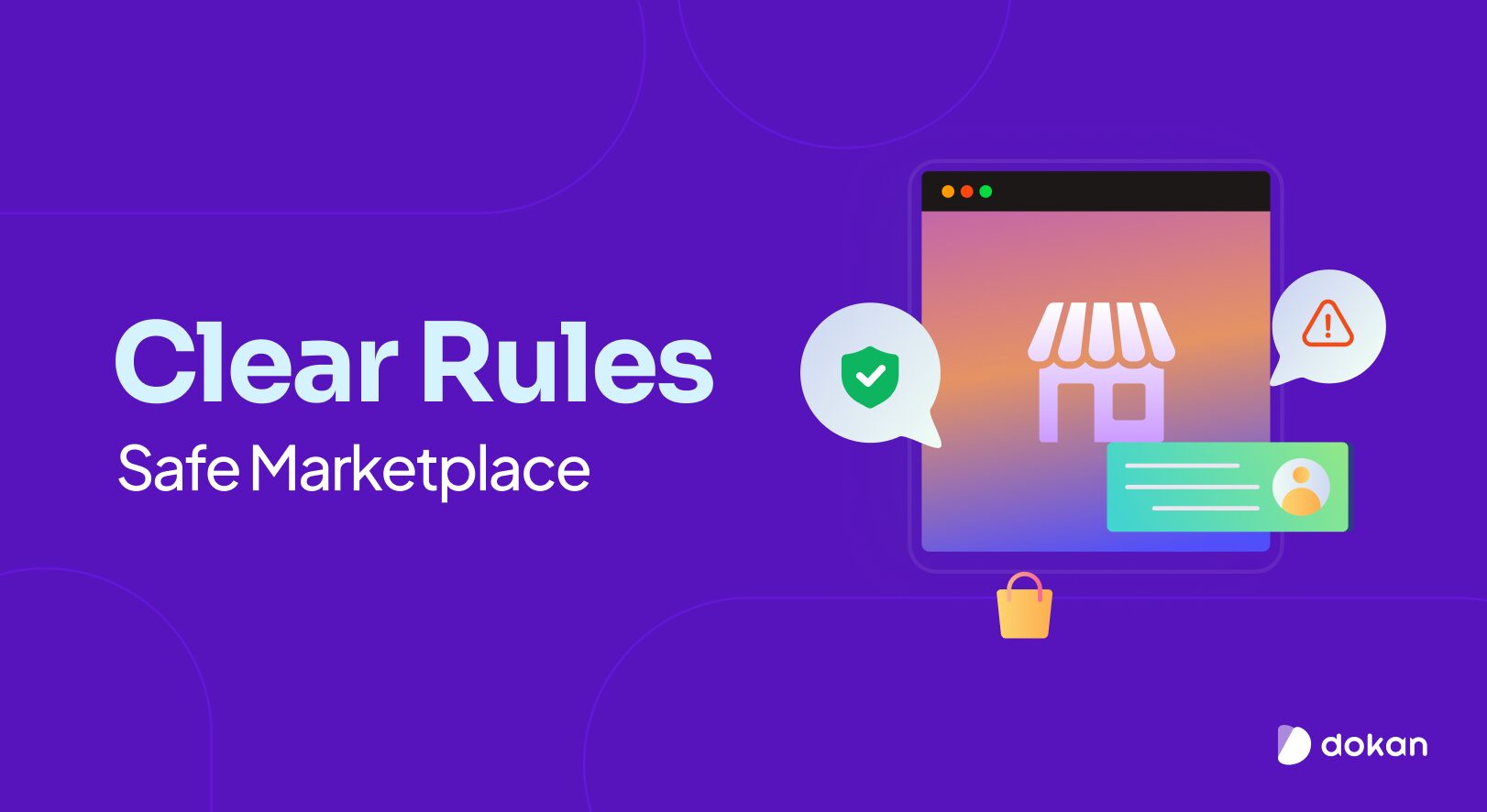If you’ve ever shopped online, you know how important it is to feel safe and confident in your transactions.
The same goes for sellers. They want to make sure they’re reaching the right audience and offering a smooth experience.
But how do you make sure both sides stay happy and everything runs smoothly? The answer is simple ⤵️
Clear and well-thought-out marketplace rules and guidelines.
With the right rules, you create a space where buyers and sellers feel safe, valued, and heard.
In this blog, we’ll dive into the essential elements every marketplace should include in its rules and guidelines.
Why Clear Rules Make Your Marketplace Shine
You might be thinking, “Do I really need all these rules?” Well, the answer is a resounding yes.
Without clear policies in place, things can quickly spiral. Sellers may post misleading product descriptions, buyers might be left frustrated with late deliveries, and disputes can turn into nightmares.
No one wants that. In fact, research shows that platforms with well-defined rules see fewer disputes, happier customers, and stronger trust in the community.
Let’s talk about why these rules matter so much for your marketplace.
- Promote Fairness and Transparency: Clear rules help everyone understand what’s acceptable and what’s not. They set expectations, so there’s no guesswork for buyers or sellers.
- Build Trust: Trust is the backbone of any successful marketplace. When your users know that you have a solid set of rules in place, they feel more confident in using your platform.
- Protect Your Business: As a marketplace owner, you need to protect yourself too. It’s your safety net when things go wrong.
- Improve the User Experience: When everyone knows how things work, the experience is smoother.
By putting the right rules in place, you create a marketplace that’s not only functional but also trustworthy and enjoyable for everyone involved.
Key Areas to Include in Marketplace Rules
Now that we’ve covered why marketplace rules are so important, let’s dive into the essential areas you should include in your guidelines.
Think of this section as your blueprint to create a fair and smooth marketplace experience for everyone.
1. User Conduct Guidelines

Your marketplace is a community. And just like any community, you need clear rules for behavior. This section is all about setting the expectations for how users should treat one another. It’s essential for creating a space where everyone feels welcome and respected.
For example, you may outline:
- Respectful Communication: Encourage users to be polite and professional. If a buyer feels something isn’t right with a product, they should reach out to the seller in a friendly, constructive way. Sellers, on the other hand, should always respond promptly and courteously to questions or complaints.
- Prohibited Behaviors: Lay down what’s not acceptable like harassment, fraud, or spamming. You can even add a section for penalties when these rules are broken. Such as temporary suspension or account bans.
This framework not only helps avoid conflict. But it also encourages a positive, welcoming community. It’s all about creating a safe space where everyone can do business without worrying about running into problems.

Subscribe to
Dokan blog
2. Product Listing Rules
Your marketplace wouldn’t exist without the products listed on it, so setting clear guidelines around product listings is crucial. It’s about ensuring consistency, transparency, and trust.
No one wants to buy something online only to receive an item that’s completely different from what was described. So, let’s avoid that with some basic rules.
Here’s what you’ll want to cover:
- Accurate Product Descriptions: Sellers must provide detailed and honest product descriptions. If you’re running a tech marketplace, for example, make sure sellers list things like product specs, features, and any other important details (the model number, compatibility, size, etc.). It helps customers know exactly what they’re buying.
- Product Photos: Encourage high-quality, clear images. No blurry photos or misleading angles. Maybe you even want to specify the number of photos required for each product listing. Let’s say you want a minimum of three shots: one from the front, one showing the side, and one zoomed-in close-up. This builds trust and ensures buyers know exactly what they’re getting.
- Prohibited or Restricted Products: Be clear about what can’t be sold. This includes anything illegal, dangerous, or harmful. If you’re running a marketplace for handmade goods, make sure sellers know that mass-produced items are off-limits.
Clear product guidelines help ensure that buyers receive exactly what they expect and it gives sellers a clear roadmap for listing their items correctly.
3. Pricing and Payment Guidelines
Pricing is one of the most sensitive areas of any marketplace. You should make sure it’s transparent, fair, and clear to both buyers and sellers. If buyers feel like they’re being overcharged or confused by hidden fees, it can lead to frustration. Marketplace sellers need to understand the pricing structure, too.
Here’s how you can lay it out:
- Clear Pricing: Sellers should provide a transparent breakdown of the product price and any additional costs like taxes or shipping. No hidden fees. For example, if you’re running a fashion marketplace, a seller should clearly list the item price and the cost of delivery upfront.
- Payment Methods: Make sure to specify which payment methods you accept. Are credit cards, PayPal, or bank transfers allowed? Being clear about this helps buyers know how they can pay and reduces confusion.
- Refund and Chargeback Policies: It’s a good idea to explain how refunds will work, especially if a product is faulty or if the buyer has an issue. Sellers should also understand the chargeback process, including the rules around returning items and getting their money back.
Transactions need to be smooth, secure, and transparent. Establishing rules around payments, refunds, and disputes helps ensure that both buyers and sellers have a fair experience.
4. Shipping and Delivery Guidelines

The shipping process can make or break a transaction. No one likes waiting weeks for their order to arrive or dealing with damaged goods.
That’s why having clear shipping and delivery guidelines is important.
Here’s what you need to include:
- Shipping Timeframes: Sellers should specify how long it will take to ship an item after it’s purchased. For example, “We ship all orders within 3 business days.” If a product is custom-made or needs extra processing time, let buyers know in advance.
- Shipping Methods: You’ll want to outline which carriers are acceptable. Whether it’s FedEx, UPS, or local postal services. Make sure sellers are clear on the shipping options available to them.
- Packaging Standards: Products should be packaged carefully to avoid damage during shipping. For instance, if a seller is sending fragile items, they should be required to pack them with extra care (bubble wrap, sturdy boxes, etc.).
- Handling Lost or Damaged Shipments: What happens if a package gets lost or damaged in transit? Make sure to outline what buyers and sellers should do in this situation. Maybe you ask sellers to provide tracking information for all orders, so it’s easy to figure out where the product is.
By providing clear shipping guidelines, you’re helping everyone involved understand what to expect, which leads to fewer issues and happier customers.
5. Handling Disputes and Refunds
Even with the best rules in place, things can go wrong. A buyer might receive a damaged product, or there could be a misunderstanding over an order. That’s where clear dispute and refund guidelines come in.

Here are the key rules to include in your guideline:
- Dispute Resolution Process: Create a system for buyers and sellers to easily file disputes. Ensure both parties can present their concerns and gather necessary evidence like photos or communication. This process should be clear and easy to follow for everyone involved.
- Refund Guidelines: Clearly explain how refunds are handled. Set timeframes for when buyers can request a refund and under what conditions a refund will be issued. Let buyers know if they need to return the product first or if a refund can be processed immediately.
- Communication Standards: Encourage buyers and sellers to communicate respectfully and promptly when an issue arises. Clear and respectful communication can often resolve problems without escalating further.
- Escalation Process:If a dispute cannot be resolved directly, have an escalation process. This might involve your team or a third-party mediator reviewing the case and making a final decision based on the evidence provided.
- Penalties for Abuse: Set penalties for users who repeatedly misuse the dispute or refund system. For example, if a seller fails to respond to disputes or buyers repeatedly make false claims, consider temporary account suspensions or other actions to prevent abuse.
A clear dispute and refund process makes it easier for both parties to feel heard and ensures that things are resolved fairly. This goes a long way in building trust in your marketplace.

6. Seller Responsibilities
Sellers are the backbone of your marketplace. So, it’s important that they understand their responsibilities to maintain professionalism and trust.
- Compliance with Laws: Sellers must obey to local, national, and international laws, including consumer protection and tax regulations. Failure to comply can result in legal risks for both the seller and the platform.
- Intellectual Property: Sellers must not list counterfeit or pirated products. Sellers should ensure they source products from legitimate suppliers and avoid using unlicensed logos or designs.
- Customer Service: Sellers must offer responsive and professional customer service. This includes addressing inquiries, resolving complaints, and ensuring product quality.
- Shipping and Delivery: Sellers are responsible for timely and accurate shipping. They should provide tracking information and meet the expected delivery times.
- Listing Accuracy: Sellers must ensure product listings are accurate, including clear descriptions, correct prices, and high-quality images.
- Respectful Behavior: Sellers should always interact respectfully with buyers, resolving conflicts professionally and avoiding any form of harassment.
When sellers follow these guidelines, they not only build trust with buyers but also contribute to running a successful marketplace.
7. Buyer Responsibilities

Buyers also have a key role in maintaining a successful and profitable marketplace. Clear guidelines for buyer behavior ensure smooth transactions and minimize disputes.
- Honest Feedback: Buyers must leave genuine, respectful reviews based on their experiences. Reviews should reflect product quality, not shipping delays or unrelated issues. False reviews or harassment towards sellers can result in penalties.
- Timely Payment: Buyers should make payments promptly to avoid delays in the transaction process. Failure to do so may result in order cancellations or penalties.
- Respecting Sellers: Buyers must treat sellers with respect, even when disagreements arise. Abusive behavior or unreasonable demands, such as expecting refunds for reasons outside the return policy, should not be tolerated.
- Clear Communication: Buyers should communicate issues respectfully, following the platform’s dispute resolution procedures rather than engaging in direct confrontation with sellers.
For keeping everything in track, here is a checklist of all the essential rules & guidelines for your marketplace ⤵️
With these steps, you can ensure a fair process for handling issues. This keeps buyers and sellers happy and builds trust in your marketplace.
Best Practices for Enforcing Marketplace Rules
Great, you’ve set the marketplace rules! Now, the main challenge is to make sure they are actually followed.
It’s not the most thrilling part of running a marketplace, but it’s essential for keeping things in line.
Let’s imagine you’re managing a marketplace and a buyer claims they received a damaged product. The seller insists it was in perfect condition when it left their hands. Now, what do you do?
Start by keeping track of what’s happening in your marketplace. You can use tools or check things manually to spot problems before they get worse. By staying on top of things, you can catch issues early and prevent them from escalating.

Now, if the buyer’s claim is true, the seller might have missed something in their packaging or shipping process. But if the buyer is simply dissatisfied with the product description, that’s a different story.
This is where you apply your rules:
- Start with a friendly reminder for the seller, telling them to review the situation and offering suggestions for improvement.
- If this is a recurring issue, a more serious approach might be necessary like temporarily suspending the seller’s account until they resolve the issue.
But what if the seller feels like they were treated unfairly? This is where having an appeal process in place is crucial. A clear, transparent system allows both parties to share their side. And you can step in with a fair resolution.
Consequences of Rule Violations
When users break the rules, it’s important to handle violations promptly and fairly to maintain a respectful marketplace.
- Warning System: Users receive a warning for minor or first-time offenses, allowing them to correct their behavior before facing harsher penalties.
- Penalties and Bans: Repeated or serious violations can result in:
- Temporary Suspension: A short-term account suspension for behavior that violates rules but can be rectified.
- Permanent Ban: For egregious or repeated offenses (like fraud, harassment), a user may be permanently banned from the platform.
Having these penalties ensures users understand the importance of following the rules and that violations will not go unaddressed.
Ready to launch your online business? Here’s the ultimate eCommerce checklist you need to turn your idea into a profitable business.
Updating and Modifying Marketplace Rules
Your marketplace is always evolving and so should your rules. As your platform grows, you may find new challenges or opportunities that require updates to your guidelines.
Here’s how to keep your rules fresh and relevant:
Periodically audit the marketplace rules to keep them relevant and effective. You should review the rules based on user feedback, legal changes, or platform growth.
According to a study by Statista, 85% of users are more likely to return to a marketplace that feels transparent and fair.
When rules are up-to-date and consistently enforced, you build a trustworthy marketplace that keeps both buyers and sellers happy.

The Secret to a Successful Marketplace? Solid Rules
We’ve covered a lot today, and it’s clear that strong, clear rules are the backbone of any successful marketplace.
Here’s the key takeaway, consistency and fairness are what make your rules work. All you need to do is regularly update them, be transparent with your users, and ensure everyone follows the same standards. That’s how you keep your marketplace running smoothly.
Now, it’s time to put this into action:
With these steps, you’ll create a marketplace that buyers and sellers trust and enjoy using.
Ready to get started? Set your rules, keep them clear, and watch your marketplace grow!
Subscribe to
Dokan blog
We send weekly newsletters, no spam for sure!






Leave a Reply